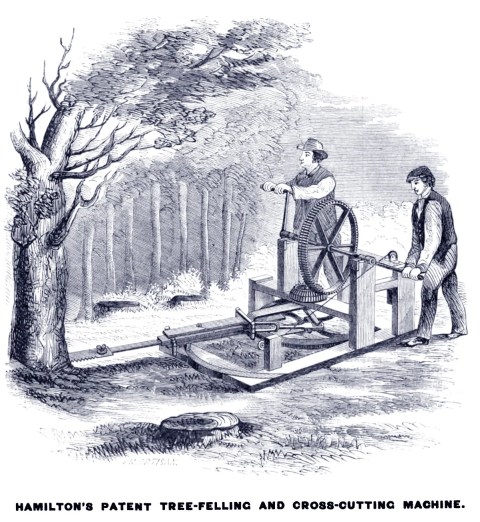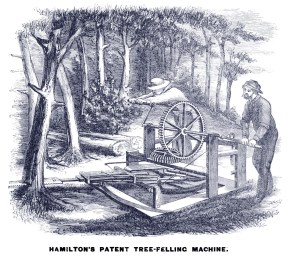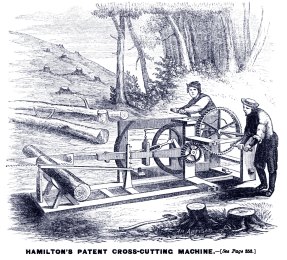
This machine is specially designed for felling trees. It is well known that in chopping down trees with an ax, two or three feet, according to the size of the tree, of the most valuable part of the lumber is lost. By this machine the tree is felled within five inches of the ground; and by removing the soil sufficiently to avoid dulling the saw, it can be cut as low as desired. Four men can do the work of ten men with axes in the forests.
It will be recollected that the butt must be squared, or cross-cut, before the log is ready for the mill; but the single operation of felling the tree with this machine leaves the log already squared. The land is left smooth, thus facilitating cultivation, and greatly increasing its value. The surface of the stump being left flat and level, is porous and spongy, so that by the action of moisture and air it soon decays; but when cut by the ax, its pores are sealed up and its surface rendered smooth, and the stump will not soon decay, but remains for years an unsightly and inconvenient object.
This machine, in cross-cutting, operates with equal facility whether the log lies flat on the ground or is elevated several feet above it. To prepare it for cross-cutting, it is turned on one side, and the shaft is put into other bearings, so that the spur-wheel and pinion gear together. The advantage gained over a common cross-cut saw, used by two men, cutting wood into shorter lengths, is that the saw works with greater rapidity, and by having greater power is fed faster.
It can be worked by one or two men, and when not employed in the forests, in sawing up the limbs, it may be used to advantage in cutting all the firewood required in the neighborhood. It is readily adapted to the several kinds of work for which it is intended, requiring less that five minutes for the necessary change of position, and practical experiment has proved its complete success and efficiency.
The power is applied by two cranks, which are sufficiently elevated above the ground to be conveniently worked. The machine is furnished with two handles, by means of which it is easily carried about by two men, and performs its work with great expedition and entire safety. A wedge, of peculiar shape, accompanies each machine, which is driven into the kerf as the saw proceeds, and thus prevents the trees from settling down, or binding the saw, and also forces the tree to fall in the desired direction.
The machine is very simple it its construction, not liable to get out of order, and moderate in cost; and is confidently commended to those interested in forest and timber lands, and all engaged in the lumber business, as effecting a great and important saving of time, labor, and material.


Col. Hamilton, the inventor of this machine, is an old and very successful inventor. His first patent was in 1809, and since that he has patented over sixty inventions, many of which are in successful use. The above-described machine was patented by James Hamilton, of New York. For further information apply to Boyd & Ackerman, at the “Hamilton Patented Machines Agency,” No. 59 Cedar Street, New York.
American Artisan and Patent Record – June 7, 1865
(Additional Illustrations – December 11, 1867)
—Jeff Burks